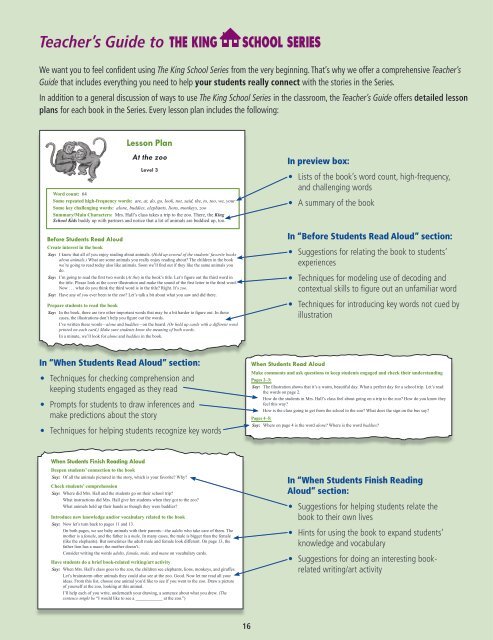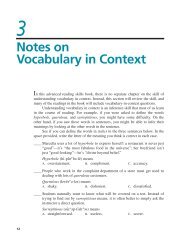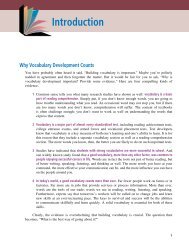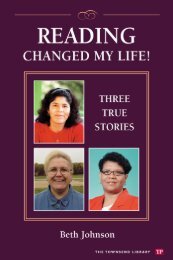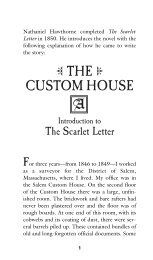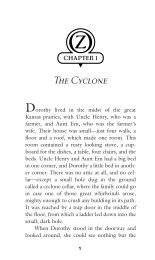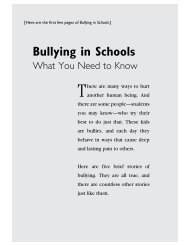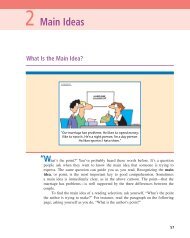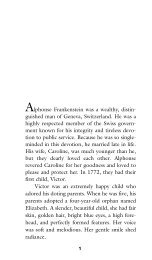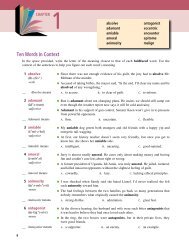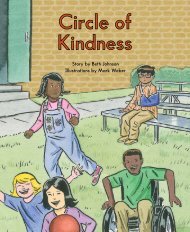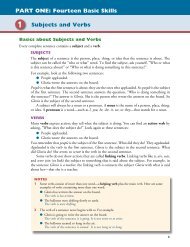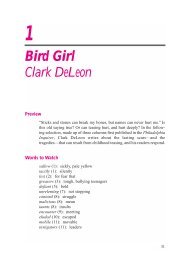New Leveled Books for Young Readers - Townsend Press
New Leveled Books for Young Readers - Townsend Press
New Leveled Books for Young Readers - Townsend Press
Create successful ePaper yourself
Turn your PDF publications into a flip-book with our unique Google optimized e-Paper software.
Teacher’s Guide to<br />
We want you to feel confident using The King School Series from the very beginning. That’s why we offer a comprehensive Teacher’s<br />
Guide that includes everything you need to help your students really connect with the stories in the Series.<br />
In addition to a general discussion of ways to use The King School Series in the classroom, the Teacher’s Guide offers detailed lesson<br />
plans <strong>for</strong> each book in the Series. Every lesson plan includes the following:<br />
Word count: 64<br />
Some repeated high-frequency words: are, at, do, go, look, not, said, the, to, too, we, your<br />
Some key challenging words: alone, buddies, elephants, lions, monkeys, zoo<br />
Summary/Main Characters: Mrs. Hall’s class takes a trip to the zoo. There, the King<br />
School Kids buddy up with partners and notice that a lot of animals are buddied up, too.<br />
Be<strong>for</strong>e Students Read Aloud<br />
Create interest in the book<br />
Say: I know that all of you enjoy reading about animals. (Hold up several of the students’ favorite books<br />
about animals.) What are some animals you really enjoy reading about? The children in the book<br />
we’re going to read today also like animals. Soon we’ll find out if they like the same animals you<br />
do.<br />
Say: I’m going to read the first two words (At the) in the book’s title. Let’s figure out the third word in<br />
the title. Please look at the cover illustration and make the sound of the first letter in the third word.<br />
Now . . . what do you think the third word is in the title? Right. It’s zoo.<br />
Say: Have any of you ever been to the zoo? Let’s talk a bit about what you saw and did there.<br />
Prepare students to read the book<br />
Say: In the book, there are two other important words that may be a bit harder to figure out. In these<br />
cases, the illustrations don’t help you figure out the words.<br />
I’ve written these words—alone and buddies—on the board. (Or hold up cards with a different word<br />
printed on each card.) Make sure students know the meaning of both words.<br />
In a minute, we’ll look <strong>for</strong> alone and buddies in the book.<br />
When Students Finish Reading Aloud<br />
Deepen students’ connection to the book<br />
Lesson Plan<br />
At the zoo<br />
Level 3<br />
In “When Students Read Aloud” section:<br />
• Techniques <strong>for</strong> checking comprehension and<br />
keeping students engaged as they read<br />
• Prompts <strong>for</strong> students to draw inferences and<br />
make predictions about the story<br />
• Techniques <strong>for</strong> helping students recognize key words<br />
Say: Of all the animals pictured in the story, which is your favorite? Why?<br />
Check students’ comprehension<br />
Say: Where did Mrs. Hall and the students go on their school trip?<br />
What instructions did Mrs. Hall give her students when they got to the zoo?<br />
What animals held up their hands as though they were buddies?<br />
Introduce new knowledge and/or vocabulary related to the book<br />
Say: Now let’s turn back to pages 11 and 13.<br />
On both pages, we see baby animals with their parents—the adults who take care of them. The<br />
mother is a female, and the father is a male. In many cases, the male is bigger than the female<br />
(like the elephants). But sometimes the adult male and female look different. On page 13, the<br />
father lion has a mane; the mother doesn’t.<br />
Consider writing the words adults, female, male, and mane on vocabulary cards.<br />
Have students do a brief book-related writing/art activity<br />
Say: When Mrs. Hall’s class goes to the zoo, the children see elephants, lions, monkeys, and giraffes.<br />
Let’s brainstorm other animals they could also see at the zoo. Good. Now let me read all your<br />
ideas. From this list, choose one animal you’d like to see if you went to the zoo. Draw a picture<br />
of yourself at the zoo, looking at this animal.<br />
I’ll help each of you write, underneath your drawing, a sentence about what you drew. (The<br />
sentence might be “I would like to see a ____________ at the zoo.”)<br />
16<br />
In preview box:<br />
• Lists of the book’s word count, high-frequency,<br />
and challenging words<br />
• A summary of the book<br />
In “Be<strong>for</strong>e Students Read Aloud” section:<br />
• Suggestions <strong>for</strong> relating the book to students’<br />
experiences<br />
• Techniques <strong>for</strong> modeling use of decoding and<br />
contextual skills to figure out an unfamiliar word<br />
• Techniques <strong>for</strong> introducing key words not cued by<br />
illustration<br />
When Students Read Aloud<br />
Make comments and ask questions to keep students engaged and check their understanding<br />
Pages 2–3:<br />
Say: The illustration shows that it’s a warm, beautiful day. What a perfect day <strong>for</strong> a school trip. Let’s read<br />
the words on page 2.<br />
How do the students in Mrs. Hall’s class feel about going on a trip to the zoo? How do you know they<br />
feel this way?<br />
How is the class going to get from the school to the zoo? What does the sign on the bus say?<br />
Pages 4–5:<br />
Say: Where on page 4 is the word alone? Where is the word buddies?<br />
In “When Students Finish Reading<br />
Aloud” section:<br />
• Suggestions <strong>for</strong> helping students relate the<br />
book to their own lives<br />
• Hints <strong>for</strong> using the book to expand students’<br />
knowledge and vocabulary<br />
• Suggestions <strong>for</strong> doing an interesting bookrelated<br />
writing/art activity


